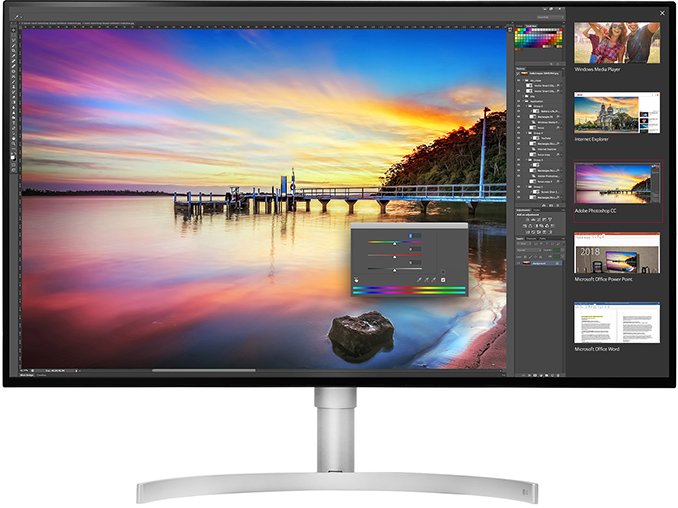LG Develops ‘Nano IPS’ LCD, Unveils 32UK950 4K Display with DCI-P3, HDR600, TB3
by Anton Shilov on December 22, 2017 5:00 PM EST
LG has announced a new kind of IPS liquid crystal panel that features an improved color reproduction. The Nano IPS technology will be used for LG’s upcoming high-end displays due in 2018 and will enable professional-grade DCI-P3 color space coverage on consumer models. One of the first monitors to use Nano IPS will be the 32UK950. The 32UK950 will be LG’s new flagship consumer 4K LCD, and will feature the VESA HDR 600 badge along with an integrated Thunderbolt 3 dock.
Nano IPS and HDR 600
LG’s Nano IPS technology will be used on numerous high-end monitors by the company, so it makes sense to examine what manufacturer tells us about it before jumping to the actual product. LG says that it applies nanoparticles to the screen’s LED backlighting to absorb excess light wavelengths and improve intensity, purity as well as the accuracy of the on-screen colors. Controlling spectral output of backlighting is a method generally used to improve IPS LCD panels — quantum dots and Panasonic’s light modulating cells do just that.
Adjusting backlighting spectral output not only enables to improve color reproduction, but also contrast ratio, but this is where LG’s press release gets vague. It never discloses or even mentions static contrast ratio, yet to get the HDR 600 badge (which is what the 32UK950 has), you need to get a black level of 0.1 nits max, which VESA believes is impossible without local dimming. However, neither local dimming, nor pixel-by-pixel control of backlight intensity, are mentioned in the press release.
Wrapping things up, we know for sure that LG’s Nano IPS enables the company to offer an improved color gamut by controlling the LED backlighting. The contrast ratio is something that is expected to be improved on new monitors as well, but LG does not say whether its Nano IPS is responsible for that.
The LG 32UK950
Among the first monitors to feature the Nano IPS technology will be the LG 32UK950. Its 32” panel has a 3840×2160 resolution, can reproduce 1.07 billion colors and cover 98% of the DCI-P3 color space. The HDR 600 badge clearly points to HDR10 processing capabilities along with up to 600 nits brightness, but LG does not disclose any information regarding its LUTs (look-up-tables) for HDR. LG’s current-generation consumer flagship display (the 32UD99-W) can cover 95% of the DCI-P3 gamut, which was a bit lower than 97% DCI-P3 coverage by the 31MU97-B, a professional display with a 4096×2160 resolution. The upcoming 32UK950 will surpass both models when it comes to gamut coverage.
| Preliminary Specifications of the LG 32UK950 | ||
| Panel | 32" IPS with Nano IPS technology | |
| Resolution | 3840 × 2160 | |
| Refresh Rate | 60 Hz (?) | |
| Viewing Angles | 178°/178° horizontal/vertical | |
| Color Saturation | 98% DCI-P3 | |
| Display Colors | 1.07 billion | |
| 3D-LUT | supported | |
| Inputs | 1 × TB3 DisplayPort 1.2 (TBC) HDMI 2.0a (TBC) |
|
| Audio | Integrated speakers | |
Another major selling point of the LG 32UK950 will be an integrated Thunderbolt 3 connectivity with daisy chaining support (enabling to connect two 4Kp60 displays using a single TB3 port on the host). Apart from TB3 headers, we expect the LG 32UK950 to feature regular DisplayPort and HDMI inputs, a USB 3.0 hub and other essential features.
LG plans to show the 32UK950 at CES trade show early next month. The company does not reveal when it intends to start sales of the new product, or its MSRP.
Related Reading
- LG’s 34UC89G 21:9 Curved Display with G-Sync, 144 to 166 Hz, Available for $999
- Pre-Orders for LG’s 32UD99 Display Available: 4K, DCI-P3, HDR10, FreeSync for $999
- LG 43UD79-B Launched: 42.5-inch 4K IPS with FreeSync
- BenQ Launches the SW271 Display for Professionals: 27-inch 4K with HDR and DCI-P3
- Panasonic Develops IPS Panel with 1,000,000:1 Contrast Ratio, 1000 Nits Brightness
- Philips Begins Shipments of LCD Monitors with Quantum Dot Technology
- LG Announces 32UD99: 4K IPS Display with 95% DCI-P3, HDR and USB-C
Source: LG











65 Comments
View All Comments
utmode - Sunday, December 24, 2017 - link
Apple will add this to their display and will call its their innovation. Good job LG, keep it up.Lolimaster - Monday, December 25, 2017 - link
They still insist with the crappy IPS, I can barely stand the low 3000:1 contrast of VA panel, but LG keep selling snake oil HDR on a 1000:1 display.Having a CRT Trinitron monitor, AMOLED Galaxy Tab S3 really makes you hate LCD + LED backlight technology.
Morawka - Monday, December 25, 2017 - link
Wow! I thought if anyone would push the limit in the PC monitor space it would be LG with their OLED technology. It seems that they never had intentions on bringing OLED into the consumer monitor space, instead they've developed this instead.Maybe someday OLED Makers will find a way to get rid of the ghosting/memory problems that OLEDS have so they will finally be suitable for PC Gaming monitors.